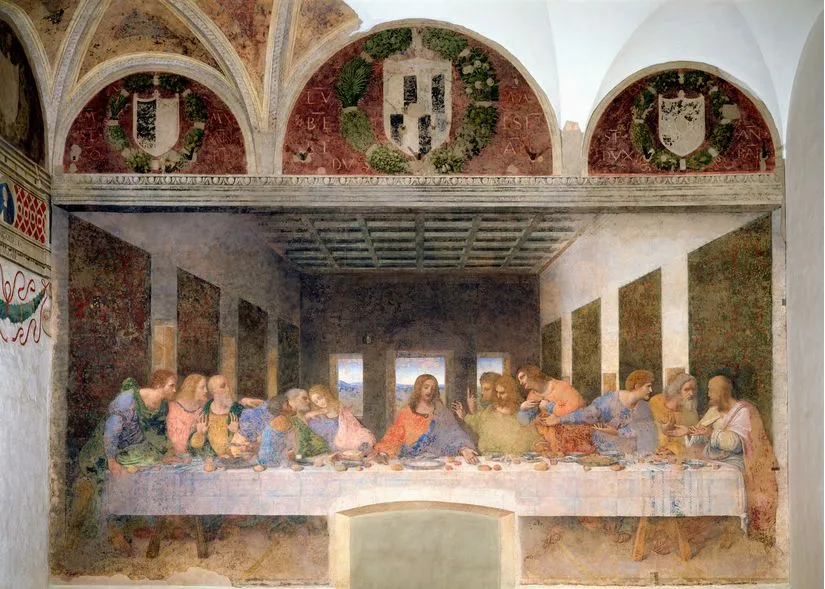
1. 최후의 만찬은 유월절을 기념하는 유월절 식사 (Passover Meal)였음
1) 유월절 식사의 의미
유월절(Passover)은 **출애굽 사건(BC 1446년경)**을 기념하는 절기로,이스라엘 백성이 애굽에서 해방된 날을 기념하는 중요한 명절이었음.
- 출애굽기 12장에 따르면, 하나님께서 애굽의 첫째 아들을 치실 때 문설주에 어린양의 피를 바른 집은 재앙에서 "건너뛰셨다"(Passover)
- 이 사건을 기념하여 매년 1월 14일(유대력, 니산월)에 유월절 식사를 하도록 명령하심.
신약에서의 의미
- 예수님께서 **최후의 만찬(The Last Supper)**에서 유월절 식사를 하시며 자신이 **하나님의 어린양(Lamb of God)**이 되어 인류의 죄를 위해 희생될 것을 말씀하심.
- 따라서, 신약에서는 유월절이 예수님의 십자가 희생과 구원의 상징이 됨.
2) 유월절 식사의 절차
예수님 당시 유월절 식사는 정해진 순서(세데르, Seder)**에 따라 진행되었음.
- 첫째 잔 (키디쉬, Kiddush)
- 포도주 첫 번째 잔을 마시며 하나님을 찬양함.
- 나물(카르파스, Karpas)
- 쓴 나물(파슬리 등)을 소금물에 적셔 먹음 → 애굽에서의 고난을 상징.
- 둘째 잔 (마가지드, Maggid)
- 출애굽 이야기를 낭독하며, 아이들이 질문을 함(마하 니쉬타, Ma Nishtana).
- 무교병(마짜, Matzah)과 쓴 나물(마로르, Maror)
- 무교병(누룩 없는 빵): 급하게 떠난 출애굽을 상징.
- 쓴 나물(쓴 상추 등): 애굽에서의 고난을 의미.
- 셋째 잔 (구속의 잔, Cup of Redemption) – 예수님이 사용한 잔
- 예수님이 "이것은 나의 피다"라고 하시며 새 언약을 세우심.
- 유월절 양(Pesach)과 식사
- 양고기, 무교병, 쓴 나물을 함께 먹음.
- 예수님 시대에는 성전에서 제사 드린 유월절 양을 가족들과 먹었음.
- 예수님은 자신이 유월절 어린양이 되셨으므로, 최후의 만찬에서 양을 드시지 않음.
- 넷째 잔 (찬양의 잔, Cup of Praise) & 찬양(Hallel)
- 시편 113~118편을 찬양하며 유월절 식사를 마침.
3. 예수님은 누구와 유월절 식사를 하셨는가?
- 예수님은 제자들과 함께 최후의 만찬을 하심 (마태복음 26:17-30).
- 가족 단위로 지키는 것이 전통이었으나, 랍비와 제자들도 함께할 수 있었음.
- 예수님께서는 자신의 십자가 희생을 가르치시기 위해 제자들과 함께 드셨음.
4. 유월절 식사는 반드시 지켜야 했는가?
- 구약에서는 모든 유대인 남성들은 유월절을 반드시 지켜야 했음 (출애굽기 12:14, 민수기 9:13).
- 유월절을 어기면 이스라엘 공동체에서 끊어질 것이라고 경고됨.
- 예수님도 이를 따라 유월절을 철저히 지키심.
신약 이후의 변화
- 예수님은 유월절을 성찬식(Communion, Lord’s Supper)으로 대체하심.
- "이것을 행하여 나를 기념하라" (고린도전서 11:24-25).
- 초대교회 이후 유월절보다 성찬식(성만찬)이 중요해짐.
- 오늘날 기독교에서는 유월절이 더 이상 필수적인 절기가 아님.
1. What Was the Passover Meal in Jesus' Time?
1) Meaning of the Passover Meal
Passover commemorates the Exodus (around 1446 BC), when God
delivered the Israelites from slavery in Egypt.
- In Exodus 12, God commanded the Israelites to sacrifice a lamb
and put its blood on their doorposts so that the Angel of Death
would "pass over" their homes. - This became an annual celebration on the 14th day of Nisan.
New Testament Meaning
- At the Last Supper, Jesus revealed that He was the Lamb of God,
sacrificed for humanity’s sins. - Thus, Passover in the New Testament symbolizes Jesus’ crucifixion and salvation.
2) The Passover Meal Procedure
In Jesus’ time, the meal followed a structured order (Seder).
- First Cup (Kiddush) – Wine is blessed and shared.
- Bitter Herbs (Karpas) – Dipped in saltwater to symbolize suffering.
- Second Cup (Maggid) – The story of the Exodus is told.
- Unleavened Bread (Matzah) & Bitter Herbs (Maror) – Represent haste and suffering.
- Third Cup (Cup of Redemption) – Jesus’ Cup
- Jesus took this cup and said, "This is My blood, the new covenant."
- Passover Lamb (Pesach) and Main Meal
- Lamb, unleavened bread, and bitter herbs were eaten.
- Jesus did not eat lamb, as He was the true Passover Lamb.
- Fourth Cup (Cup of Praise) & Psalms (Hallel)
- Psalms 113-118 were sung to end the meal.
3. With Whom Did Jesus Eat the Passover Meal?
- Jesus ate the Last Supper with His disciples (Matthew 26:17-30).
- Passover was traditionally eaten with family,
but rabbis could also eat with their disciples. - Jesus chose His disciples to share this meal,
teaching them about His coming sacrifice.
4. Was It Mandatory to Keep the Passover Meal?
- In the Old Testament, all Jewish males were required to keep Passover
(Exodus 12:14, Numbers 9:13). - Failing to observe it meant being cut off from Israel.
- Jesus faithfully observed Passover throughout His life.
Changes in the New Testament
- Jesus replaced Passover with Communion (Lord’s Supper).
- "Do this in remembrance of Me." (1 Corinthians 11:24-25)
- After the early church, Communion became the key Christian practice,
and Passover was no longer necessary.
4o
'5. Bible Q&A' 카테고리의 다른 글
| Bible Q&A : 최후의 만찬을 식탁에서 한 것인가? (마태 26:20) (0) | 2025.03.20 |
|---|---|
| Bible Q&A : 최후의 만찬의 시간적 배경인 무교절&유월절이란? (마태복음 26:17) (0) | 2025.03.20 |
| Bible Q&A : 개혁 신학적 관점에서 복음(Gospel)의 의미 (0) | 2025.03.18 |
| Bible Q&A : 예수님은 정학히 언제 돌아가셨나요? (0) | 2025.03.18 |
| Bible Q&A : 성경에서 말하는 기름 부음의 의미는? (0) | 2025.03.14 |